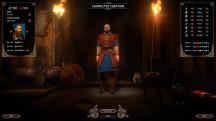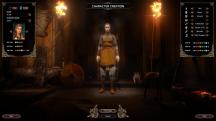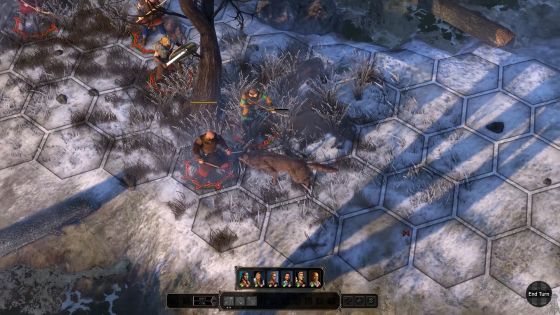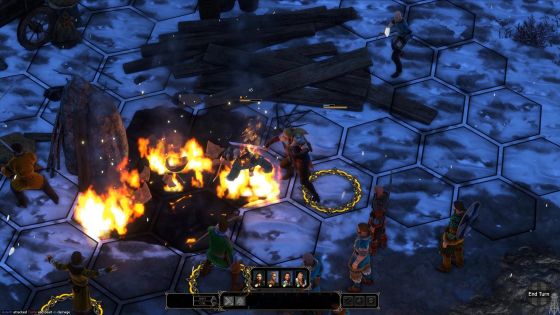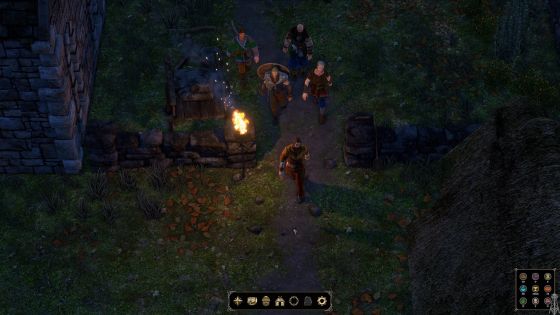Expeditions: Viking Preview

Last year at Gamescom I met with Alex Mintsioulis from Logic Artists to talk about their new game, Expeditions: Viking. That presentation covered the England campaigns, traveling, camping, and some combat. This year Alex showed me a part of the Denmark campaign, which focused for the most part on character creation and combat, but we also got to discuss other things, such as the changes to what was shown last year.
We played a part of the first campaign of Expeditions: Viking. Norwegians are raiding the village, for reasons unknown, until you capture one of them. There are three battles that take place. If you win two of the three battles you get one outcome and if you lose two of the three battles you get a different outcome.
On the winning side, you get to capture the leader of the Norwegians, named Gunnar the Peaceful, a very powerful character. During interrogation you have the chance to recruit him, if you make the right choices during that interrogation. If you lose, he escapes, denying you the chance to recruit him. You can still interrogate him to get the same information.
Losing in a fight will never end the game. It effects certain types of outcomes, such as whether you win or lose in combat. However, you do sustain injuries, for which you will need healing, but you won't die just like that. However, untreated injuries will fester and eventually lead to a character's death. The game ends if the main character dies from his or her wounds.
One of the significant differences between Viking and Conquistador is that you don't draft your crew at the start of the game. A major part of the first campaign is gathering the crew for your ship. As long as you don't have a crew or a ship, your village is under constant attack since it is seen as weak. You can collect crew members from the starting village and from your travels through Denmark. The first two people that join you are your two best friends, which you have known for a long time. One of them is a spear-wielding shield maiden, and the other is a hunter with a bow. The advantage of a spear in the game is that you have a longer reach and you can pass one hex, so you hit someone at a two hex distance. You can even go over the head of standing before you, or over defensive formations. In addition, you don't have any issues with attack of opportunity as that works only for adjacent hexes. You can't dismiss any of your party members during the first campaign, as they are essential to the narrative.
Party members have their own plotlines and story elements, and their unique personalities are significant. They have morale, but the developers have not yet finalized how this morale will work out when they disagree with you, and if it could lead to mutiny or party members deserting. TA dueling mechanic was considered, but the downside of that is that even though 1-on-1 turn-based combat can be challenging, you could build your character specifically for dueling and duels would become too easy and boring. On the other hand, if you don't build your character for it, the duel would be quite difficult.
Once the first campaign is completed, party members can be dismissed at your discretion and be replaced by other party members that you find during your travels. You can also hire mercenaries, but these do not have any narrative elements.
At the start of the game you create your character. You can select the gender and looks of your character and then select one of the predefined character types to set your stats and skills. You can also just create your character from scratch if you like or modify one of the predefined character types. The video at the end of this article shows a bit of the character creation in the first minutes.
The predefined characters were actually only put in the game for conferences and events, like Gamescom, so people did not need to spent a long time with character creation. The initial idea was that in the final game you would build your character from scratch. They use the description section to tell you what kind of character you are making, which is also used for building the narrative around your character. The predefined characters are created so that they also have different narratives. Once the developers realized that there are people who like these predefined characters, they decided to keep them in the game.
Besides setting the primary stats of your character (Strength, Endurance, Finesse, Perception and Sense) you can also select your skills. This is similar to how it was in Conquistador. There are weapon skills, of which two were not yet implemented, nor would Alex say what they were. What is implemented are axes, bows, knives, shield, spear, sword and unarmed. Then there are also offensive skills, like dual wielding, where you can add an axe or a dagger to your off-hand, naturally forfeiting you the use of a two-handed sword. There are passive skills, like back-stabbing and sneak attack, hardened and quick feet, which allows you to maneuver around a character without triggering attack of opportunity. Then there are the camping skills and the support skills, like leadership, which not only gives you a buff, but also unlocks conversation options. Some other skills in that last section are trap spotting, healing and witchcraft. However, as the game is classless, you can develop your character in the game any way you want.
Before my visit, I played a battle in the public Nordic booth and barely survived with only one character standing. So we decided to do one of the other battles in this hands-on session. When entering a battle, another difference with Conquistador becomes visible, as the battle maps in Viking are now integrated in the environment.
For this battle, the party was automatically joined by people from the village, so that the battle was an even match on both sides and that we ended up with 6 fighters, with melee, ranged and spear skills. The combat is turn-based, like in Conquistador. You can make use of your environment by hiding behind barricades, but also by making use of environmental hazards, of which some are interactive and some are not. An example of a non-interactive hazard are patches of ice; if you walk on them, there is a chance that your character will slip and fall and cannot use their next turn. One of the interactive hazards that were shown was tar pots. You can use an arrow to break the pot and have another character throw a burning torch on it. You could also do it with a sword instead of an arrow, but the tar will spread fairly quickly and also cover your feet, which will give you the status effect "flammable", making you susceptible to going up in flames if you're near fire. The fire from the tar will grow with every round that the battle lasts. The earlier this is done in combat, the more it will have grown during combat. There will be more things like this in the final game, but at the moment there is one other, which is a beehive that you can shoot down from a tree, sending a cloud of bees to wreak havok on the characters below them. These things give the players the ability to manipulate the battlefield and have something similar to an AOE spell.
Some of the skills that you can use in combat can be quite powerful and will, because of that, be limited to a certain number of uses per combat. One example is quick-shot, which gives a bit of an aim penalty, but if you are close enough that doesn't matter much. However, the big advantage is that it allows you to shoot twice, instead of just once. When you have selected the type of attack you want to perform, hovering over that opponent will show you how much damage you can expect to deal. You can use this to determine which skill to use for that character and whom to attack in this turn. For more details on combat be sure to check out the video at the end of this article.
Currently there is no friendly fire in the game. It's being considered, but the devs also want to make sure that playing an archer feels as valuable and useful as any other character. For this they are working on several things. One of them is that when your arrow misses, the character gets a status effect, "harried", which means the character is unnerved. After all, an arrow just flew by and missed the character by a few inches. The character's brush with death gives them a bit of a debuff. So, even if you shoot and miss, something comes out of that action.
For a melee character, the game does not have a hit percentage. You hit every time, but the damage you do will vary. If your opponent carries a shield, they have a chance of blocking the attack. If they succeed in blocking the attack, the shield's durability soaks up the damage. As mentioned, for range attacks you don't always hit.
If you only follow the main storyline, you should be able to get a boat and a party and sail to England in 10-15 hours and start raiding there. In Denmark you don't really do any raiding, since you live there. You will get into fights and people will attack you, but in general, your time at home will be more quest-driven and slightly more linear. The main storyline involves learning how to build ships, then constructing one. You also need to gather a crew, which means a lot of traveling around in order to find enough people to join you. And you will also need to fight your rivals in order to consolidate your power.
Like you move on the campaign map from A to B, you also move on the campaign map from Denmark to England. There is no sailing mechanic, but there are events that can happen while you are at sea. Conversations will occur, people will get sick, and so on. Conquistador featured a similar narrative experience from being on the ship.
When you reach England, you will land and establish a staging ground. Other Vikings are already here, staging raids from their own beachheads. Moving inland from your staging ground, you will discover new locations. Any new locations you find accessible by water allow you to sail to that new location and create a new staging area there.
In northeast England, you will find the Northumbrians, and to the north in Scotland, the Picts. These groups are in conflict with one another, as well as dealing with internal conflicts. You're able to work with both initially if you want to, or you can pick a side. However, each of them has their own unique political landscape. The Northumbrians are Catholic, and the rules of their faith and culture prevent them from trading with the heathen Vikings. The current Northumbrian king in the game is especially pious and wants nothing to do with Vikings. The former king, who has been deposed, wants his kingdom back and is more favorable towards you. How you deal with these situations is up to you. You have the option of getting involved in their politics, allying yourself with the deposed king, or simply leaving the strife behind and going out to raid on your own.
Last year I was shown a preliminary version of the England campaign map and the camping mechanic. The new version is much improved, but the developers were not happy with it being shown to others, so they did not put it in the build. What Alex could tell me was that you travel between locations on the campaign map, requiring you to camp in the camping locations that appear. Last year, the camping spots would generate when you were ready to camp and would create different camping spots with varying stats. This has now been changed by placing the camp locations manually on fixed spots. They still will have different stats, so some are better than others. This allows the developers to have more control over how difficult it is to explore an area.
On the campaign map in Denmark there is no fog of war. This is your home and you know what it looks like. The campaign map in England is completely covered in fog and all areas need to be explored, so you do have to discover camping locations in order to be able to use them.
More on this topic can be found in last year's Gamescom article. Just be aware that it's a work in progress and that some things might be different in the end. The camping mechanics are still the same; crafting, hunting, witchcraft, guarding, and cooking are still in the build. Cleaning up the camp after you're finished is still a must as well, erasing signs of your passing and keeping the campsite safe for later use. If you don't clean up, people will know you've been there, which creates a possibility for an ambush the next time you decide to camp there.
The developers are aiming for about 40 hours of playtime from the main story line, with more added on when you do the side quests.
Expeditions: Viking is scheduled for Q1 2017 and will not be available in early access, as the dev team feels it would reveal too much about the campaign.
You can check out the gameplay video below:
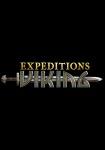
Information about
Expeditions: VikingDeveloper: Logic Artists
SP/MP: Single-player
Setting: Historical
Genre: Strategy-RPG
Combat: Turn-based
Play-time: Unknown
Voice-acting: Unknown
Regions & platforms
World
· Platform: PC
· Released: 2017-04-27
· Publisher: EuroVideo Medien
More information



